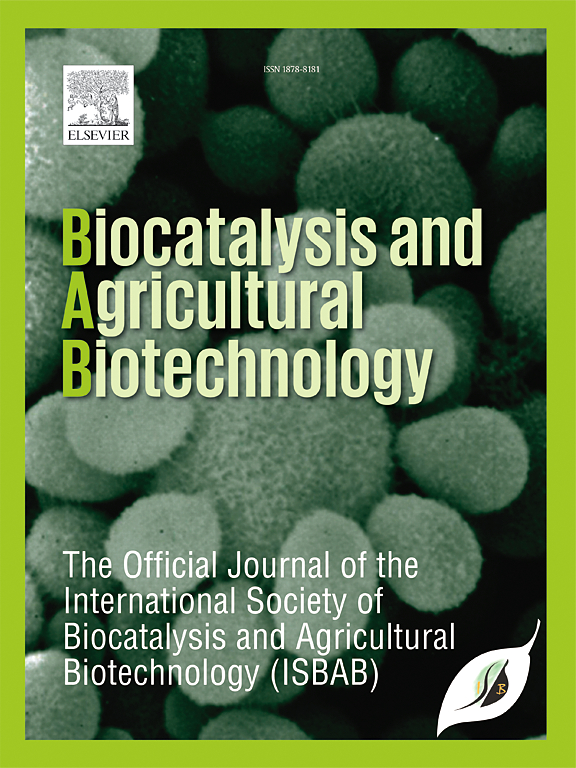Larvicidal activity, oxidative stress, and enzymatic alterations induced by essential oil from Piper cyrtopodon (Miq.) C.DC (Piperaceae) on Aedes aegypti (Culicidae)
IF 3.4
Q2 BIOTECHNOLOGY & APPLIED MICROBIOLOGY
引用次数: 0
Abstract
Dengue, Zika, and chikungunya are mosquito-borne diseases transmitted by Aedes aegypti, with over 13 million dengue cases, 431.223 chikungunya cases, and 44.242 Zika cases reported in the Americas in 2024. The resistance of Ae. aegypti to synthetic insecticides has driven the search for botanical alternatives, such as essential oils (EOs) from Piper species. This study evaluated the EO from Piper cyrtopodon and its main compounds as larvicides, investigating their mechanism of action. The EO, extracted by hydrodistillation (yield: 1.4 ± 0.2 %), contained germacrene D (57.46 %), cadina-1(10),4-diene (10.57 %), and δ-elemene (8.0 %). It showed significant larvicidal activity against Ae. aegypti, with LC50 values ranging from 20.78 to 146.61 μg/mL over 24 and 48 h. Cadina-1(10),4-diene was the most active compound (p < 0.0001). Biochemical analyses revealed oxidative stress in larvae, with increased reactive oxygen species production (11 ± 2 to 26 ± 2 μmol H2O2/g), lipid peroxidation (0.54 ± 0.06 to 2.8 ± 0.22 ηmol MDA/g), and protein oxidation (1.62 ± 0.04 to 4.54 ± 0.51 nmol/mg protein) compared to controls (p < 0.0001). Antioxidant enzymes superoxide dismutase (10.33 ± 3 to 28.33 ± 6 mU/mg protein), catalase (1.04 ± 0.09 to 7.08 ± 2.42 mmol H2O2/min/mg protein), and glutathione peroxidase (5.40 ± 1.37 to 14.67 ± 1.52 mmol NADPH/min/mL) were altered, suggesting redox imbalance as a toxicity mechanism. These findings highlight the potential of the EO from P. cyrtopodon as a natural alternative for Ae. aegypti control.

Piper cyrtopodon精油诱导的杀幼虫活性、氧化应激和酶促改变c.d.c(胡椒科)对埃及伊蚊(库蚊科)的影响
登革热、寨卡和基孔肯雅是由埃及伊蚊传播的蚊媒疾病,2024年美洲报告登革热病例超过1300万例,基孔肯雅病例431.223例,寨卡病例44.242例。伊蚊的抗性。埃及伊蚊对合成杀虫剂的抗性促使人们寻找植物替代品,如胡椒属植物的精油(EOs)。本研究对虎牙的EO及其主要杀幼虫化合物进行了评价,探讨了其作用机制。用加氢蒸馏法提取的环氧乙烷(收率为1.4±0.2%),含锗烯D(57.46%)、癸二烯-1(10)、4-二烯(10.57%)和δ-榄香烯(8.0%)。对伊蚊有明显的杀幼虫活性。24和48 h的LC50值在20.78 ~ 146.61 μg/mL之间。Cadina-1(10),4-二烯是活性最高的化合物(p <;0.0001)。生化分析表明,与对照组相比,幼虫的氧化应激增加了活性氧(11±2至26±2 μmol H2O2/g)、脂质过氧化(0.54±0.06至2.8±0.22 ηmol MDA/g)和蛋白质氧化(1.62±0.04至4.54±0.51 nmol/mg protein)。0.0001)。抗氧化酶超氧化物歧化酶(10.33±3 ~ 28.33±6 mU/mg蛋白)、过氧化氢酶(1.04±0.09 ~ 7.08±2.42 mmol H2O2/min/mg蛋白)和谷胱甘肽过氧化物酶(5.40±1.37 ~ 14.67±1.52 mmol NADPH/min/mL)发生改变,提示氧化还原失衡是其中毒机制。这些发现突出了P. cyrtopodon的EO作为Ae的天然替代品的潜力。蚊控制。
本文章由计算机程序翻译,如有差异,请以英文原文为准。
求助全文
约1分钟内获得全文
求助全文
来源期刊

Biocatalysis and agricultural biotechnology
Agricultural and Biological Sciences-Agronomy and Crop Science
CiteScore
7.70
自引率
2.50%
发文量
308
审稿时长
48 days
期刊介绍:
Biocatalysis and Agricultural Biotechnology is the official journal of the International Society of Biocatalysis and Agricultural Biotechnology (ISBAB). The journal publishes high quality articles especially in the science and technology of biocatalysis, bioprocesses, agricultural biotechnology, biomedical biotechnology, and, if appropriate, from other related areas of biotechnology. The journal will publish peer-reviewed basic and applied research papers, authoritative reviews, and feature articles. The scope of the journal encompasses the research, industrial, and commercial aspects of biotechnology, including the areas of: biocatalysis; bioprocesses; food and agriculture; genetic engineering; molecular biology; healthcare and pharmaceuticals; biofuels; genomics; nanotechnology; environment and biodiversity; and bioremediation.
 求助内容:
求助内容: 应助结果提醒方式:
应助结果提醒方式:


